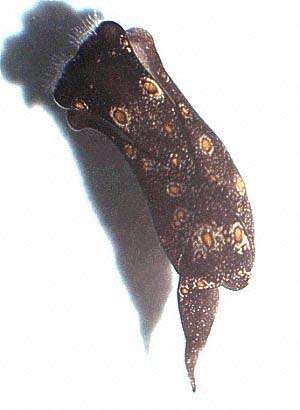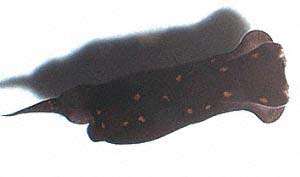

Chelidonura sandrana
Rudman, 1973
Order: CEPHALASPIDEA
Family: Aglajidae
DISTRIBUTION
Originally described from Tanzania, in East Africa, but I have also found this species on the Great Barrier Reef, Queensland.
PHOTO
Kunduchi Beach, Dar es Salaam, Tanzania, November 1973. Maximum length 17mm. UPPER: Common East African colour form with white markings. Note prominent sensory bristles on each side of the mouth. LOWER: uncommon East African form with only yellow spots. PHOTOS: Bill Rudman.
I originally found this species in large numbers crawling over fine coral sand in a shallow lagoon at Paje in Zanzibar in 1971. I was visiting Paje because Sir Charles Eliot, who published so much on East African nudibranchs, had a residence there when he was the British government representative there at the turn of the century. I had no suitable container for collecting so only managed to collect 4 specimens. They were crawling in an area densely covered with small flatworms, which first gave me the idea that flatworms were a likely food for Chelidonura, an idea recently confirmed by Sea Slug Forum participants. I later found it quite commonly in Dar es Salaam on mainland Tanzania. Most specimens had yellow and white markings. The yellow-spotted form was very rare.
Since finding a similarly shaped small species of Chelidonura in similar places on the Great Barrier Reef, but without the white "petals" around the yellow spots, I am inclined to think that C. sandrana may be synonymous with Chelidonura tsurugensis which was described from Japan. In both species the ventral surface of the animal is black, without the dorsal colour pattern.
As I named this species after my wife, I have been in no great hurry to synonymise it with Chelidonura tsurugensis but Bob Bolland's photo certainly suggests they are very similar.
The other alternative is that there are two species. One point of difference is that the two white patches on the front of the head in C. tsurugensis are absent in "typical" C. sandrana. White patches on the head are only present in specimens with only the yellow spots. This could suggest there are two species, C. tsurugensis with a wide distribution throughout the Indo-West Pacific, and C. sandrana restricted to the Indian Ocean. Any photos of "typical" C. sandrana from the Pacific would be of interest.
[Note added 9 Feb 2000]: Another name for this species is C. babai Gosliner, 1988, described from Aldabra Atoll in the Indian Ocean - see Terry Gosliner's message below.
Reference:
• Rudman, W.B. (1973) On some species of Chelidonura (Opisthobranchia: Aglajidae) from Zanzibar and Fiji. Zoological Journal of the Linnean Society, 52: 201-215.
Rudman, W.B., 1998 (October 27) Chelidonura sandrana Rudman, 1973. [In] Sea Slug Forum. Australian Museum, Sydney. Available from http://www.seaslugforum.net/factsheet/chelsand
Related messages
-
Larvae of Chelidonura sandrana
From: Johannes Faber, November 20, 2006 -
Colour form of Chelidonura sandrana
From: Gillian Elliott, March 11, 2003 -
Chelidonura sandrana colour morphs
From: Nils Anthes, January 25, 2003 -
Re: Chelidonura sandrana - feeding
From: Nils Anthes , January 18, 2003 -
Chelidonura sandrana - feeding in lab
From: Nils Anthes, January 15, 2003 -
Re: Chelidonura? from the Philippines
From: Erwin Koehler, December 3, 2002 -
Chelidonura? from the Philippines
From: Erwin Koehler, December 2, 2002 -
Chel. sandrana & C. tsurugensis mating
From: Lindsay Warren, March 29, 2001 -
Re: Chelidonura sandrana complex
From: Terry Gosliner, February 9, 2000 -
Chelidonura sandrana & look-alikes
From: Lindsay Warren, February 5, 2000
